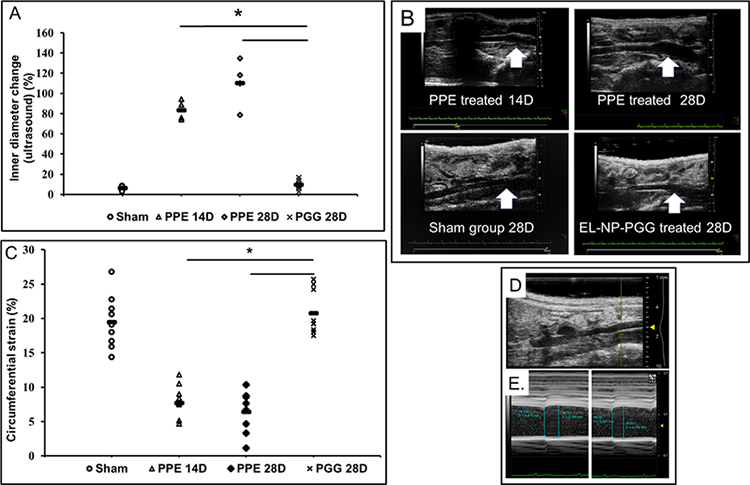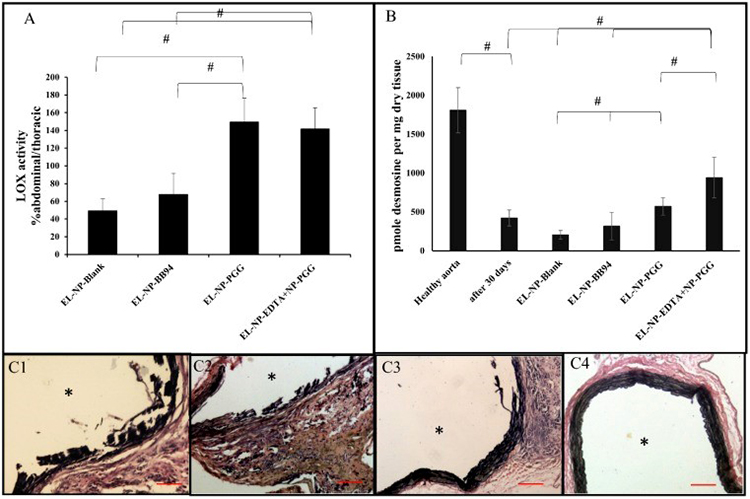Abdominal aortic aneurysms (AAA) is characterized by chronic inflammation and degradation of extracellular matrix (ECM) components by proteolytic enzymes like MMPs. This can lead to inflammatory infiltration in the adventitia and calcification and degeneration of medial elastic lamina. Here, we tested whether dual therapy with targeted nanoparticles (NPs) can remove mineral deposits (by delivery of a chelating agent, ethylene diamine tetraacetic acid (EDTA)) and restore elastic lamina (by delivery of a polyphenol, pentagalloyl glucose (PGG)) to reverse moderate aneurysm development
2. EDTA followed by PGG NP delivery led to reduction in macrophage recruitment, matrix metalloproteinase (MMP) activity, elastin degradation and calcification in the aorta as compared to delivery of control blank NPs. Such dual therapy restored vascular elastic lamina and improved vascular function as observed by improvement in circumferential strain. Therefore, dual targeted therapy may be an attractive option to remove mineral deposits and restore healthy arterial structures in moderately developed aneurysms. Moreover, our recent study demonstrated that, PGG targeting to the degraded elastin reversed advanced stage aneurysm in an elastase-induced mouse model of AAA
3.
Figure 2: (A) LOX activity in the abdominal part (CaCl2 injured) over the thoracic aorta (non-injured, healthy), showing that LOX activity was reduced in the EL-NP-Blank and EL-NP-BB94 groups. The EL-NP-PGG and EL-NP-EDTA+EL-NP-PGG groups showed increased LOX; both are significantly higher than the EL-NP-Blank and EL-NP-BB94 groups. (B) Desmosine content of aorta 30 days post injury and in the four NP groups was compared to healthy non injured abdominal aorta. CaCl2 injury caused a substantial decrease in desmosine. Desmosine content was not improved after delivery of blank or BB-94 loaded NPs (EL-NP-Blank or EL-NP-BB94). The EL-NP-EDTA+EL-NP-PGG group showed the highest desmosine content among the four groups.
*EL-NP-EDTA: elastin antibody-conjugated EDTA loaded NPs
**EL-NP-PGG: Elastin antibody-conjugated PGG loaded NPs

Figure 3: Reversal of aneurysm after PGG nanoparticle treatment. Representative data of the internal diameter of the aorta as measured by ultrasound. A. Representative scatter plot showing the internal diameter of the aneurysmal region of abdominal aorta decreases significantly after the PGG nanoparticle treatment (EL-PGG-NP) in comparison to elastase treated control (PPE) group. * p <0.0001 as compared to control. B. A representative B-mode ultrasound in vivo scan of aortas showing the internal diameter decreases in EL-PGG-NP group. The size of aneurysm increased from Day-14 to Day-28 in the control group, and it was noticeably decreased after PGG nanoparticle treatment. C. Scatter plot of circumferential Green-LaGrange strains throughout the cardiac cycle. The control group showed decreased strain, suggesting stiffening of the aorta due to the loss of elastin. In the EL-PGG-NP group, the circumferential strain of aneurysmal aortas increased significantly aortas were similar to sham control at Day-28 (p < 0.0001) showing improved elasticity. D and E. Representative M-mode in vivo ultrasound images of abdominal aorta showing the measurement of systolic and diastolic diameter.
References
2. Nosoudi, N., Chowdhury, A., Siclari, S., Karamched, S., Parasaram, V., Parrish, J., ... & Vyavahare, N. (2016). Reversal of vascular calcification and aneurysms in a rat model using dual targeted therapy with EDTA-and PGG-loaded nanoparticles. Theranostics, 6(11), 1975.
3. Dhital, S., & Vyavahare, N. R. (2020). Nanoparticle-based targeted delivery of pentagalloyl glucose reverses elastase-induced abdominal aortic aneurysm and restores aorta to the healthy state in mice. Plos one, 15(3), e0227165.

